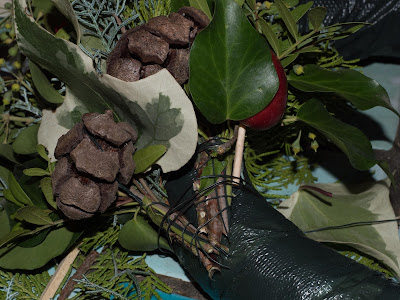Recently we've been holding our winter meetings at Françoise McCredie's charming residence in Cotignac. She is so welcoming. This was the first indoor meeting after the summer and normally we start the season with a pot-luck lunch. We were very lucky that this time we had Rens Korting devoting one day of her holidays to give several demonstrations of how to make an attractive flower arrangement for Christmas.
Françoise and Jean next to the greenery used in the arrangements
Unfortunately it was raining most of the day. Our plans to hold the demonstration outside had to be changed at short notice. The kitchen was used and because of its large central work station it turned out to be ideal.
Some of the utensils used: a rope for a garland, a wreath, secateurs to cut the branches. etc.
Rens
We'd asked Tineke to make photos so that all our members could use the photos as examples.
The finished circular arrangement and the wreath
The first example was a circular arrangement, the same method can be used for a rectangular shape:
If you use 'Oasis' for the arrangement, you need a basin filled with water, you drop the 'Oasis' into the water and let it soak up the water till it is saturated.
The saucer with the prongs to hold the 'Oasis'
The prongs are glued to the saucer with pieces of double sided tape
Melting the tape a little for a stronger adhesion
You place the 'Oasis' on the prongs. Cut off the edges to make the shape a bit more rounded. The first branches are pushed into each side of the 'Oasis'.You finish of the basic structure with putting another branch on the top of the 'Oasis'. If you use a particular branch on one side, it looks nicer to do the same on all the sides.
Examples of greenery you can use i.e. branches of Ivy, multi-couloured ivy leaves with stalk, branches of different types of conifers, Pistachia lentiscus, Phillyrea angustifolia, in fact any evergreen shrub or tree growing in your garden or area. Cut a piece of the branch, and shape the end into a point.
The smallest size of wire should be used when attaching leaves to the arrangement
To use a leaf in the decoration you use the end of the wire as a needle, your thread it through either side of the central vein, you twist it round the stalk and the other bit of wire, you cut off the wire to the length required, then push it into the 'Oasis'.
Small fruit can be used by pushing it onto a wooden BBQ stick normally used for kebabs
Work in progress
To make a bow, it is easier to used wired ribbon, you fold it into the shape of a bow
You wrap a length of wire around the centre of the bow, then twist the 2 ends of wire together to be able to push it into the 'Oasis'
Wreaths are available nearer to Christmas at 'Gamme Vert'
The second example was a wreath for a door. There was not enough time to finish the wreath, Rens showed us the principles of how to go about it.
To hide the straw of the wreath you cover it with green plastic. It comes in a roll. If you cannot find it you can use dustbin bags cut into strips. When you come to the end, fasten it with a bit of insulating tape. You need about 3.5 metres of plastic wrap.
Next, make a hook to hang the wreath. You use pliable wire on a spool to create the hook. When you have finished making the hook, fasten a bit of string to the hook to find the hook later, after you have covered the wreath with greenery.
Make a small bouquet with different bits of greenery, then bind it together with the pliable wire.
Fasten the bouquet with pliable wire to the wreath
One bouquet on the outside, the next one on the inside, both at a bit of an angle fastened with the wire
An apple on a BBQ stick, just push it into the wreath
Another example of how to fasten the bouquets to the wreath
The finished wreath
How to make a garland:
You need a piece of rope, quite thick or otherwise like in this case you wire two bits of rope together. Make a large loop at the end to hang it on a hook or door handle. A hanging garland is easier to work with.
Cover the rope with plastic, the same way as for the wreath
Make small bouquets the same way as was done for the wreath. Attach the bouquets to the rope with pliable wire on a spool just as was done for the wreath.
Finished garland
You may want to attach a double bow to the arrangement
Behind the normal bow, you form another loop
and another loop
you pinch the loops together, wrap the wire around the middle
Finished bow
Rens with our thank you present
At our next Garden Group Meeting on 29 November, I'll bring along some prongs to use for the round or rectangular arrangement, let me know if anyone is interested.
Photos: Tineke Stoffels, a big thank you for the detailed photos.








































































